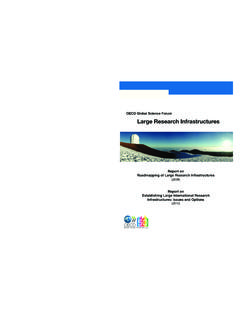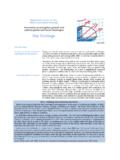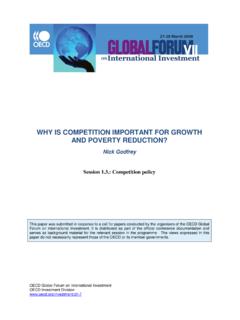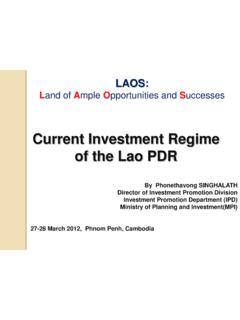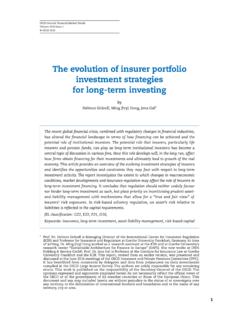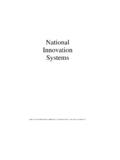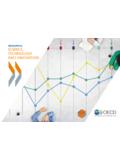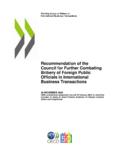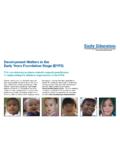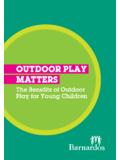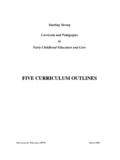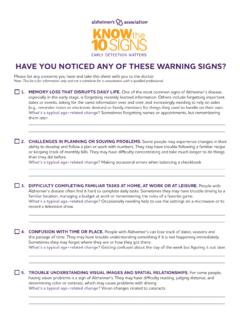Transcription of Quality Matters in Early Childhood Education and …
1 Quality Matters in Early Childhood Education and Care sweden Miho Taguma, Ineke Litjens and Kelly Makowiecki Quality Matters in Early Childhood Education and Care: Sweden 2013. Miho Taguma, Ineke Litjens and Kelly Makowiecki This work is published on the responsibility of the Secretary-General of the OECD. The opinions expressed and arguments employed herein do not necessarily reflect the official views of the Organisation or of the governments of its member countries. This document and any map included herein are without prejudice to the status of or sovereignty over any territory, to the delimitation of international frontiers and boundaries and to the name of any territory, city or area.
2 ISBN 978-92-64-17674-4(PDF). The statistical data for Israel are supplied by and under the responsibility of the relevant Israeli authorities. The use of such data by the OECD is without prejudice to the status of the Golan Heights, East Jerusalem and Israeli settlements in the West Bank under the terms of international law. Photo credit: cover Mark Yuill - Corrigenda to OECD publications may be found on line at: OECD 2013. You can copy, download or print OECD content for your own use, and you can include excerpts from OECD publications, databases and multimedia products in your own documents, presentations, blogs, websites and teaching materials, provided that suitable acknowledgement of OECD as source and copyright owner is given.
3 All requests for public or commercial use and translation rights should be submitted to Requests for permission to photocopy portions of this material for public or commercial use shall be addressed directly to the Copyright Clearance Center (CCC) at or the Centre fran ais d'exploitation du droit de copie (CFC). at FOREWORD - 3. FOREWORD. This publication is intended to be a quick reference guide for anyone with a role to play in encouraging Quality through Sweden's Early Childhood Education and care (ECEC). curriculum. There is a growing body of evidence that children starting strong in their learning and well- being will have better outcomes when they grow older.
4 Such evidence has driven policy makers to design an Early intervention and re-think their Education spending patterns to gain value for money . At the same time, research emphasises that the benefits from Early interventions are conditional on the level of Quality of ECEC that children experience. What does Quality mean? Starting Strong III: A Quality Toolbox for Early Childhood Education and Care has identified five policy levers that can encourage Quality in ECEC, having positive effects on Early child development and learning. Policy Lever 1: Setting out Quality goals and regulations Policy Lever 2: Designing and implementing curriculum and standards Policy Lever 3: Improving qualifications, training and working conditions Policy Lever 4: Engaging families and communities Policy Lever 5: Advancing data collection, research and monitoring Of the five policy levers, Sweden has selected Policy Lever 2: Designing and implementing curriculum and standards for its current policy focus.
5 The OECD Secretariat would like to thank the national co-ordinator, Mr. Christer Toft nius, for his work in providing information. We would also like to thank all those who gave their time to respond to our many questions, provide comments on preliminary drafts and validate the information for accuracy. We would also like to thank consultants Janice Heejin Kim and Matias Egeland who worked on sections of the preliminary drafts as part of the OECD team on ECEC. The online version of the Quality toolbox can be found at: The online toolbox has additional information, such as a country materials page where actual documents from OECD countries are presented, including curricula, regulatory frameworks and data systems information.
6 All information related to the OECD Network on ECEC is available at: Quality Matters IN Early Childhood Education AND CARE: SWEDEN OECD 2013. TABLE OF CONTENTS - 5. TABLE OF CONTENTS. FOREWORD .. 3. EXECUTIVE SUMMARY .. 7. INTRODUCTION .. 9. Aim of the policy 9. Structure of the report .. 9. CHAPTER 1. WHAT DOES RESEARCH SAY?.. 11. What is curriculum? .. 12. What is at stake? .. 12. Why does it matter ? .. 13. What aspects matter most? .. 14. What are the policy implications? .. 18. What is still unknown? .. 20. References .. 21. CHAPTER 2. WHERE DOES SWEDEN STAND COMPARED TO OTHER COUNTRIES? .. 25. Strengths .. 26. Potential areas for reflection.
7 34. CHAPTER 3. WHAT ARE THE CHALLENGES AND STRATEGIES? .. 43. Common challenges .. 44. Sweden's efforts .. 45. Possible alternative strategies: Lessons from New Zealand, Norway and Portugal .. 48. References .. 58. ANNEX. DEFINITIONS AND 59. Tables Table Effects of academic and comprehensive curriculum models .. 15. Table Different curriculum models' effect on school 15. Table Summary of major ECEC curriculum programmes/approaches/traditions .. 30. Table Engagement of parents in ECEC .. 34. Figures Figure Impact of different curriculum models .. 18. Figure Sensitive periods in Early brain development .. 19. Figure Coverage of ECEC curriculum frameworks or guidelines by age group.
8 27. Figure Content areas included in ECEC 31. Figure Expectations of parents regarding their children's Education and skills .. 33. Figure Approaches of ECEC curriculum .. 36. Figure Immigrant population .. 37. Figure Child obesity going up .. 38. Figure The use of ICT .. 39. Figure Content of professional 41. Quality Matters IN Early Childhood Education AND CARE: SWEDEN OECD 2013. EXECUTIVE SUMMARY - 7. EXECUTIVE SUMMARY. A common curriculum framework helps ensure an even level of Quality across different forms of provision and for different groups of children. ECEC has always been an important topic in Sweden but is receiving increased policy interest, as improving Quality in the ECEC sector is a subject of growing importance.
9 The OECD has identified five effective policy levers to encourage Quality in the sector: 1) Quality goals and regulations; 2) curriculum and guidelines; 3) workforce; 4) family and community engagement; and 5) data, research and monitoring. Of the five aspects, Sweden considers improving Quality through curriculum as a priority; it considers a well-designed balanced curriculum as key to providing high- Quality ECEC with the most favourable holistic outcomes for children. With a weak curriculum framework, children may miss out on stimulating environments that are of high importance during the Early years. A common framework in the form of a curriculum or learning standards helps staff to clarify their pedagogical aims, keep progression in mind, provide a structure for the child's day, focus on the most important aspects of child development, and respond adequately to children's needs.
10 It can also ensure continuity between ECEC and primary schooling, ensuring that children are equipped with the knowledge and skills needed for primary school and further learning. Additionally, a common framework helps parents learn about child development and encourages them to ensure a good home learning environment; and it can act as a bridge between staff and parents for information sharing about what children do in centres as well as facilitate needs-based interventions. Designing curricula based on cognitive and neurological science can contribute to the age-appropriateness of activities and ensure that children do not miss out on relevant development elements.

